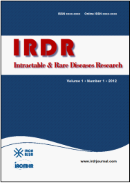Drug Discov Ther. 2018;12(4):233-238. (DOI: 10.5582/ddt.2018.01033)
Constipation in the elderly in a Japanese long-term medical facility: An ultrasonographic investigation.
Yabunaka K, Nakagami G, Tabata K, Sugama J, Matsumoto M, Kido Y, Iuchi T, Sanada H
This study aims to assess the fecal retention in elderly patients using colonic ultrasonography (US) in Japanese long-term care facility and determine the correlation between nutrition management methods and the fecal retention by US. This cross-sectional, single-center study was conducted in a long-term care facility in Japan. Patients with chronic constipation fulfilled the Rome III criteria for the diagnosis of functional constipation. US was performed on constipation patients with 4-day fecal retention before starting the standard management of constipation. After patients had defecated, nurses checked the outside of feces using King's Stool Chart and Bristol Stool Chart. All of 32 patients underwent the management of suppository laxative, the daily life independence level in grade C. In all cases, the King's Stool Chart did not detect > 200 g of fecal matter; the Bristol Stool Chart revealed type 5-7 in 56.2% of patients. The total parenteral nutrition and tube feeding did not completely detect type 1-2 in 0%. While the fecal retention groups comprised 15.6%, the non-fecal retention groups comprised 84.4%. The total parenteral nutrition did not completely detect the fecal retention in 0%. In the non-fecal retention groups, the King's Stool Chart indicated < 100 g in 81.8%, and the Bristol Stool Chart indicated type 5-7 in 100%. In conclusion, fecal properties of elderly constipation patients with the long-term parenteral nutrition should be assessed in follow-up examination by US, which is possible for personalized medical care by US, to avoid the administered regular management of constipation.







